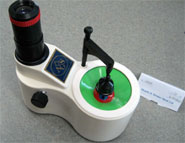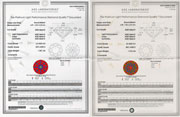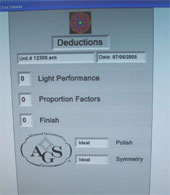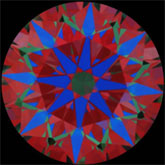Cut Grades Arrive in America
In the early mid 1990s when Hearts and Arrows (aka H&A)

Fig C-1
began to trickle into America, they were much more high-tech than the grading labs were. When GIA began to encounter H&A diamonds a few things jumped out from the report. The diamonds were extremely round, tables were 55-57%, the girdles were medium or thin to medium and polish and symmetry were excellent. This kind of consistent cutting was unheard of at the time and cut grading did not exist yet in America.
A sample of an early H&A GIA report circa 1997
Fig C-1
These new Japanese imports would become “a game changer” and the US diamond business was about to change forever…
AGS Triple Ideal, the new face of Ideal Cut
In 1996, almost a decade before GIA would unveil their cut grade system,
the American Gem Society opened their own laboratory. AGS sought to create
a vehicle for AGS jewelers to convey cut grading in an easy to understand
0-10 number system. Their top grade was 0 zero (Ideal) and the lowest grade
was 10 (poor). At the time there was no major gem lab in America that
graded the cut of a diamond so this new
two-dimensional proportion set
grading system with it’s top grade of AGS 000 (aka Triple Zero) became
the new standard for “Ideal Cut” diamonds. It became the report of choice
with Hearts and Arrows sellers and some new Websites that came on line in
the late 90s. Within a few years AGS modified their report, addressing
among other things, deeper stones, thick girdles and steeper pavilion
angles. Unfortunately, some diamonds once graded
AGS 0, were downgraded
to
AGS 3 based solely on girdle thickness. AGS members were tepid in
their support of the new lab so the AGS board voted to allow AGSL reports

Fig A-1
to be offered to the general trade in late 1997. This proportion-based
AGS system enjoyed much success and created a large pool of users both
foreign and domestic who saw a need that AGS alone had filled. Other
second tier labs began to mimic AGS with their own “Ideal” grades, but
their standards were too loose and not very credible, nor based on science.
After a series of minor changes in methodology, AGS made a major shift in June 2005.
They jettisoned their old two-dimensional “Legacy” proportion system for a completely new method.
The new AGS three-dimensional Light Performance Grading System would scan a diamond to create
a three-dimensional file and then use optical ray-tracing software to evaluate the
three-dimensional model. AGSL developed a tool to judge light performance called ASET,
an acronym for Angular Spectrum Evaluation Tool. See Fig A-1
This method would calculate a diamonds ability to reflect, refract and
return light to the observer. In so doing, the interaction of all of the
diamond’s facets are measured and considered. Many Hearts and Arrows
dealers have continued to use the AGS 000 report since its inception.
Today we believe the AGS DQD Platinum report with ASET image is the closest
thing to a true H&A diamond report in the US today. True Hearts and Arrows
show a bright blue arrows pattern against a red background on the ASET image,
if the pavilion and crown angles are at proper relationship to each other.
It is important to understand: Not all AGS 000’s are H&A Ideals!
The parameters that make Hearts and Arrows go far beyond those for AGS 000,
as we will demonstrate in our technical section.
Below are two AGS 000 DQD Platinum reports. One of them

Fig A-2 and A-3
is an H&A and the other is not. Can you see the difference?
Fig A-2, A-3
The centerpiece of their new system is based on Angular Spectrum Evaluation Tool or ASET.
Fig A-4, A-5

Fig A-4

Fig A-5
GIA finally gets into the game
In the 1950’s, GIA developed their color and clarity nomenclature that has
remained the worldwide industry standard. They were the first to issue grading
reports using these terms as well as basic measurements including: table and
depth percentages, girdle thickness, culet size and finally polish and symmetry
grades, but no overall cut grade. Finally in 2005, “after more than 15 years of
research and discovery”, they unveiled a controversial cut grade system with
their top grade of Excellent.
There is a presumption in the trade today that the Excellent Cut designation on GIA reports is synonymous with Ideal or Hearts and Arrows cutting. While it is a fact that all true H&A Ideals submitted to GIA would garner their top grade, one should not assume that all “Triple Excellent” stones are automatically Hearts and Arrows. It is important to understand what Excellent means and how the GIA arrived at their top grade.
Reflecting on the development of the GIA Cut Grade GIA’s Tom Moses wrote, “The most exciting and reassuring conclusion of our research is that there is no single set of proportions that define a well-cut round brilliant diamond. Our research has shown that many different proportions can produce attractive diamonds.”
In 2005, Tom Yonelunas, CEO of the GIA Laboratory made this claim about their
new system, “Diamond manufacturers will be able to cut round brilliants to a
wider range than the current norm and still achieve top grade, great-looking
diamonds. These findings will potentially allow for greater yield and greater
weight retention from the rough.”
GIA’s Generic Ideal cut report became the darling of manufacturers who could now “hawk” average stones as Ideal Cut
And so it was that GIA came up with a cut grade system that included “many different proportions”. Too many perhaps, so that their top grade was too broad and therefore not really that “excellent” after all! Unfortunately, GIA had become so vocally “anti-Ideal Cut” in the years before the rollout of their new system, they made sure everyone could find a home in this new “Excellent Adventure”. Their top grade has become a “catch-all for better makes” from the best Super Ideals to some very mediocre cut diamonds.
GIA Excellent Cut... not so excellent?
So it was in January 2006, that GIA’s new Generic Ideal cut report became the darling of manufacturers worldwide, as well as some big Websites, who could now “hawk” average stones graded Excellent as “Ideal Cut”. Cutters were thrilled that at the world’s top lab, Excellent now included diamonds with 62% tables, total depths up to 63.6%, crown angles as low as 31.5° and pavilion angles up to 41.8°! Below: GIA Cut Grade Values and Ranges Fig G-2
Table size: 52% to 62%
Depth percentage: 58.1% to 63.6%
Pavilion angle (Main): 40.6° to 41.8°
Crown angle (Bezel): 31.5° to 36.5°
Lower girdle halves: 70% to 85%
Star length: 45% to 65%
Girdle (min/Max): Thin to Slightly Thick
Culet: None to Small
Polish: VG-EX
Symmetry: VG-EX
Fig G-2
Cutters could now cut diamonds with greater yield and still get an Excellent cut grade! Mr. Moses stated, “Our research is that there is no single set of proportions that define a well-cut round brilliant diamond”. This is an understatement.
Compare that statement to the 1979 GIA Diamond Grading course where it was stated in Assignment #23: “The ideal angle for the pavilion is approximately 40 3/4° or 41°, and that for the crown 34.5°. The angle of the pavilion main facets with the plane of the girdle is a vital consideration in determining the brilliancy of the diamond. Since any material departure from a 40 3/4° to 41° angle is sure to reduce brilliancy, most cutters adhere closely to this angle.”
It’s true that not all diamonds graded Excellent at GIA are mediocre, but that is the problem, many are. So what about those Tolkowsky type, tight tolerance Hearts and Arrows Diamonds? GIA does not have a “Super Excellent” grade. How does one separate these superior diamonds from weaker makes with the same label? It’s like putting a Bentley and a Cadillac together into the same “luxury car” category! Anytime a luxury brand becomes “too general” or generic, it loses its cache. This may be the fate of GIA’s Excellent over time, as people become more educated about cut. This is why the American Gem Society Laboratories has remained a reliable alternative for scientifically quantifying top cutting.
The purpose of this website is to change the focus of the diamond world to the most important factor of diamond quality: CUT
After all, what should buyers expect of an “Excellent cut” diamond? Shouldn’t they expect a diamond that reflects and refracts light to the highest possible degree: a diamond that delivers maximum light performance, scintillation (sparkle) and dispersion (fire)?
It has always baffled the trade that diamond buyers seem to care about small differences in color and clarity grades, with the surprising insistence on one grade over another. Yet these same buyers will often settle on an average cut diamond that “doesn’t deliver the goods”! It is obvious that they don’t understand that subtle differences in cut can have a huge impact on diamond beauty…much more than one or two color or clarity grades can. Times are changing and buyers are demanding products that are technically superior to those they have purchased in the past. Diamonds are no exception! A new millennium has dawned and thanks in part to the Internet; it is an age of enlightenment. Consumers educate themselves before they shop and they demand more information before they buy. They are often better informed than sales people they encounter. Times have changed.
1992 Sarin DiaMension introduces a computerized non-contact measuring device Fig H-1
1994 Associated Gem Labs of Japan unveils AGL “Triple Excellent” cut grade report Fig H-2, Fig H-2A
1996 AGS Introduces proportion-based DQD Report featuring AGS 000 Fig H-3
2000 AGS refines the proportions of their DQD Report
2005 AGS introduces light performance grades, scrapping their two-dimensional proportion based grading system Fig H-4
2006 GIA introduces their first cut grade on their GTL reports on January 1, 2006 (3x Excellent) Fig H-5
2008 AGS Introduces DQD Platinum report (w/ ASET image) Fig H-6